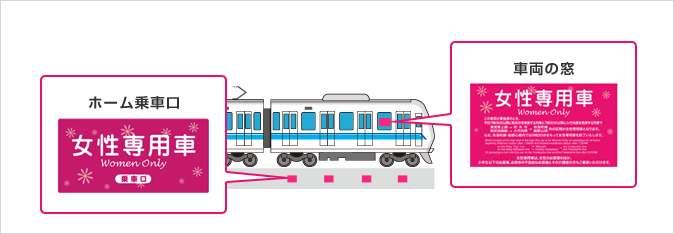Many people should have heard of the women-only compartments of the Japanese tram, because of the frequent occurrence of perverts(Chikan in Japanese, refers to both the offender and the act of touching others without their consent) on the Japanese tram, in order to ensure the safety of female passengers, women-only trains were born.

Here are a few tips on women-only trains in Tokyo in the form of a question and answer session.
Q: Are all tram lines equipped with women-only compartments?
A: No, not really. Some lines on the JR, Tokyo Metro, Seibu, Odakyu, Tokyu, Keio, and Keisei lines have women-only trains.
Japan Pocket Wifi Rental
UNLIMTED DATA SIM CARD
Japan Travel Prepaid SIM card
Q: Where are the women-only trains usually located on the trains?
A: On Tokyo trains, the first or last car is usually located. In Osaka, they are mostly located in the middle of the train. It is easy to tell which train is reserved for women because there are pink signs on the outside of the train, on the glass and on the platform.
Q: Are all male passengers not allowed to use the train?
A: No, not really. Boys and girls in elementary school or below, as well as those with disabilities or those who are ill and need care, can ride with their caregivers in the women-only trains.
Q: I often see many men riding in women-only trains.
A: In Tokyo, women-only trains are only available for a few hours during the morning commute, and all passengers, including men, can use them at other times. In Osaka, the women-only trains on the Midosuji subway line are available from Monday to Friday on weekdays. For JR lines in the Kansai region, such as the Osaka Loop Line, JR Kyoto Line, JR Kobe Line, etc., women-only trains are available from start to finish every day (including weekends and holidays). Therefore, it is not unusual to see male passengers on women-only trains in Tokyo during the noon hour.
Also, even though they are both on the morning commute, the women-only trains may be set up differently in different directions on the same line. For example, on the Chuo Line Rapid (orange tram), women-only trains are only available in the direction of Tokyo Station during the morning commute. Therefore, you may occasionally see many male passengers riding in the trains with women-only trains during commuting hours.
In general, women-only trains are designed according to most people’s daily routes, for example, in the morning, many people leave from other prefectures near Tokyo, or suburbs of Tokyo, to go to work in the 23rd district. Therefore, for example, the Chuo Line express trains heading to Tokyo are much more crowded than the Chuo Line express trains heading in the opposite direction, such as Aomori and Otsuki, so only the crowded trains heading to Tokyo are equipped with women-only compartments.
For more information on the availability of women-only trains on specific lines in the Kansai region, please check the Osaka Police Department website.
https://www.police.pref.osaka.jp/07sodan/madoguchi/chikan_sodan/senyo_list_1.html
Q: How can I quickly tell which compartment is for women?
A: As briefly mentioned above, there are usually two places where you can identify a women’s compartment. One is on the platform, where you can check the sign on the floor while waiting for the train.
On the other hand, you can see a sticker like the one below on the glass of the train or on the body of the train (the picture below shows the sticker on the women’s compartment of JR East, which may be slightly different in other regions and on other lines).

Women-only train stickers
Q: What should I do if I accidentally ride in a women-only car without paying attention?
A: Don’t panic. If you find that you have accidentally taken a women-only compartment, you can move to the next general compartment on the tram. If you can’t move right away, you can wait until the train arrives at the next stop and then switch to the next compartment.
I ride the women-only compartment every morning, and I often encounter male passengers who take the train by mistake. Although there are occasionally Japanese commuters, foreign tourists are the majority. In Tokyo, women-only trains are not available all day, so even Japanese people occasionally make a mistake, and they usually quickly realize that they are on the wrong car and move to the next car in silence (although there have been cases where they listened to music all the way and were completely lost in their own world without realizing they were on the wrong car).
If a foreign tourist makes a mistake, some of them will move to a regular car as soon as possible. However, I have met many foreign male passengers who did not notice that they were in the wrong compartment, and if the female passengers around you realize that you are a foreigner, basically no one will come out and tell you that this is a women’s compartment. But in Osaka, you may be corrected by female passengers, because of the straightforward nature of Kansai people.
You may find the following articles helpful
Japan Pocket Wifi Rental
UNLIMTED DATA SIM CARD
Japan Travel Prepaid SIM card
